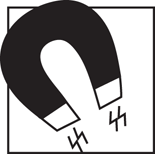
Making Moves
How Do the Ends of Magnets Affect Each Other?
Materials
- 2 bar magnets
Try This
- Lay both magnets on a table.
- Slowly slide one end of the first magnet toward one end of the second. What happens?
- Slowly slide the other end of the second magnet near the same end of the first magnet. What do you feel this time?

What's Going On?
The ends of a magnet behave differently from one another. Magnets have poles, called “north” and “south,” where the magnetic forces are concentrated. When placed near each other, the same, or “like,” ends of magnets repel (push away) each other, whereas the opposite ends attract (pull toward) each other. When you moved the two like ends of the magnets close together, you felt the strong repelling force. When you moved the opposite ends close together, the magnets reached a point where they quickly attached to each other. The ends of all magnets behave this way. If we cut a magnet in half, the new ends too would behave this way.
